ON THE RECORD: COMPLETE TEST OF THE 2005 YAMAHA YZ125
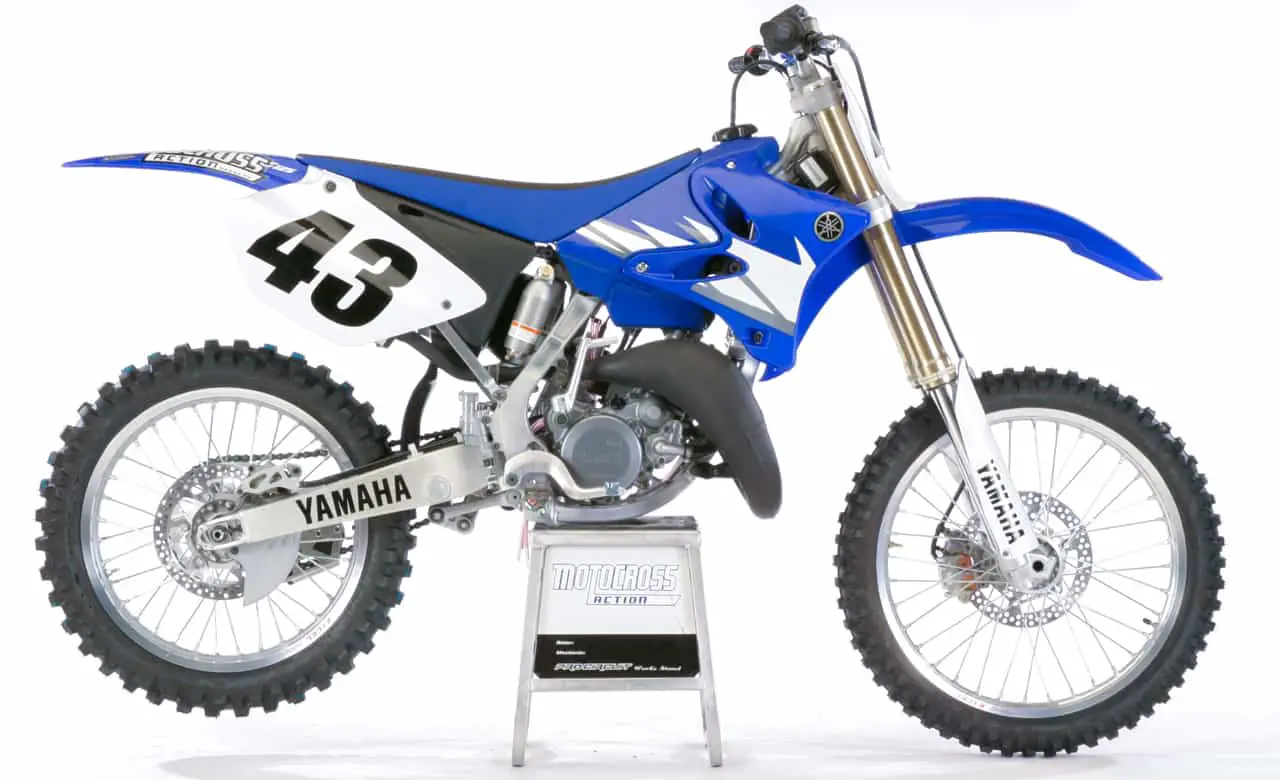 2005 was the first year Yamaha went to an aluminum frame on their YZ125. It hasn’t changed since.
2005 was the first year Yamaha went to an aluminum frame on their YZ125. It hasn’t changed since.
The year was 1996 and Yamaha had unleashed a monster of a 125 after years of tiddler mediocrity. The 1996 YZ125 was a defining moment in 125 history. Since that year Yamaha has refined and updated, but not radically changed the YZ125. Why not? The reason was simple, why ruin a good thing. The only glitch in the game plan? They did ruin a good thing when they released the YZ250F four-stroke. The YZ250F was the death knell of the YZ125. Or was it? If two-strokes were dead then why did Yamaha waste time building a totally new dinosaur in 2005? They had a reason. In 2005 Yamaha decided to build an all-new YZ125 two-stroke; not a reworked 1996 model, but a completely new bike that shared almost no parts with the 2004 model.
Q: WHAT DIDN’T YAMAHA DO TO THE 2005 YZ125?
A: You probably thought that we’d ask what they did to it first, but the didn’t list is much shorter. They didn’t change the look of plastic (although we wish they had), clutch plates, clutch perch, kickstarter, grips, footpegs, rear brake, hubs, rims and tires.
Q: WHAT DID YAMAHA CHANGE IN 2005?
A: Everything else. And that included the plastic. Say what? Didn’t we just say that they didn’t change the plastic? No, we said “the look of the plastic,” the plastic itself was a completely new recipe that held its color longer and lessened the white stripes syndrome. Underneath the new plastic recipe was a completely new motorcycle. Yamaha spared no expense on the 2005 YZ125. Suspending the all-new engine and all-new frame were all-new Kayaba 48mm Air-Oil Separate System forks. Kayaba SSS suspension wouldn’t make its debut until 2006.
Q: HOW RADICALLY DIFFERENT WAS THE 2005 YZ125 ENGINE FROM THE 2004?
A: They only shared two parts, the kickstarter and clutch plates. Everything else was ash-canned. Yamaha’s goal was to build the lightest 125 two-stroke possible and since the engine was the heaviest part of the motorcycle, it was the best place to start. The 2005 YZ125 engine was four pounds lighter than the 2004 YZ125 engine. That’s impressive.
Q: WHAT DO THE INNARDS OF THE 2005 YZ125 ENGINE LOOK LIKE?
A: Yamaha ditched the domed piston for a flat-top piston. They shortened the connecting rod 3mm. They raised the exhaust port 0.5mm. They tilted the engine forward 7.5 degrees so they could straighten the intake tract from 16 degrees off-center to 5 degrees (this is a big deal). The coolant port on the head had been changed because of the engine tilt. The water pump impeller changed to plastic and the shaft was 4mm smaller. The clutch actuator arm was now located inside the ignition cover (just like every other 125 in the class). The transmission was a six-speed (hallelujah). The exhaust pipe had a straighter initial section.
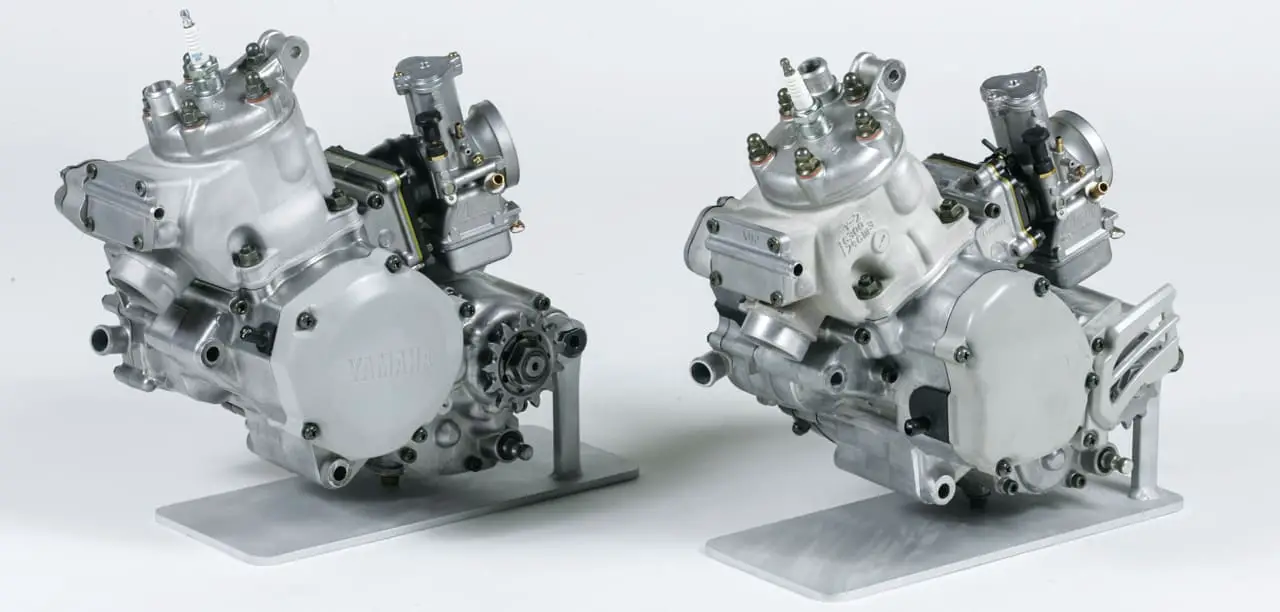 Left is the 2004 engine and right is the 2005-2018 engine.
Left is the 2004 engine and right is the 2005-2018 engine.
Q: WAS THE 2005 YZ125 ENGINE BETTER THAN THE 2004 ENGINE?
A: Absolutely. Positively. Without a doubt. The 2005 engine was better than the 2004 in every aspect. It came on earlier, pulled harder and revved longer, but don’t get to excited because it traded some ridability for a pure race set-up. It is a no-holds-barred race engine. It had to be ridden hard and put away wet. As long as you keep it on the pipe and caught gears in the midrange you’d be flying. Miss a shift or let the engine bog down and you’d be flicking the clutch and shifting down in a hurry. Yamaha is to be commended for building a full-race YZ125. Two-strokes have advantages over four-strokes, but being broad, torquey and easy to ride aren’t on the list. To make a 125 engine beat a bike that has twice the displacement, you have to give up the niceties and go straight for the jugular. If you are an animal, the 2005 Yamaha YZ125 was your kind of machine.
Q: WAS THE 2005 YAMAHA YZ125 BETTER THAN THE 2005 YZ250F FOUR-STROKE?
A: If you are a diehard two-stroke rider, read no further. The truth is that while we loved the 2005 YZ125 and considered it to be the best 125 two-stroke ever made at the time, it wasn’t going to displace the 2005 Yamaha YZ250F in the minds of American motocrossers. When you’re flicking the clutch in third on the YZ125, you’re pulling hard in third on the YZ250F. Actually, you’re probably thinking about catching fourth. While you’re shifting from first to second to third on the YZ125, your still in the same gear on the broader powerband of the YZ250F. The thumper was less work. A thumper rider didn’t have to be as skilled. Consider the YZ125 a super two-stroke. If you’re a super two-stroke rider you will be able to hang with the 250Fs.
Q: WHY WOULD SOMEONE BUY A 125 TWO-STROKE BACK IN 2005?
A: That is a very important question, not just to the people who spend money to buy motocross bikes, but to the people who build them. Why should someone buy a 125 two-stroke? There are several good reasons: Fun factor: This thing is a blast to ride. It revs quicker than any four-stroke and when you are jamming from gear to gear you feel like you are flying. It has the feel of speed. Cost of ownership: We aren’t telling tales out of school when we tell you that you could blow up four 125 two-strokes for the cost of one four-stroke snuff. Two-strokes are inexpensive to maintain. If you blow up a four-stroke you might have to replace the cylinder, piston, crank, valves, head, valve guides, cam chain and cams. We’re talking a huge chunk of change. We know people who have switched back to two-strokes because they spent $6000 for a four-stroke, then had to dump another $3000 into it to fix it. If that doesn’t sound bad we should mention that they couldn’t ride for six months while they waited for parts and tried to save enough money to pay for them. Weight: The 2005 Yamaha YZ125 weighed 197 pounds. That’s about 20 pounds lighter than all the 250 four-strokes. Exactly how light it is becomes very clear once you get the bike out on the track or have to lift it up on a stand. You feel almost invincible on the 2005 YZ125. The bike is so light it seems to skip over all the bumps, clears every jump with relative ease and turns on a dime. The 2004 YZ125 weighed 208 pounds and it was about par for the course. Trust us, you’d notice the ten pound weight reduction on the 2005 YZ125.
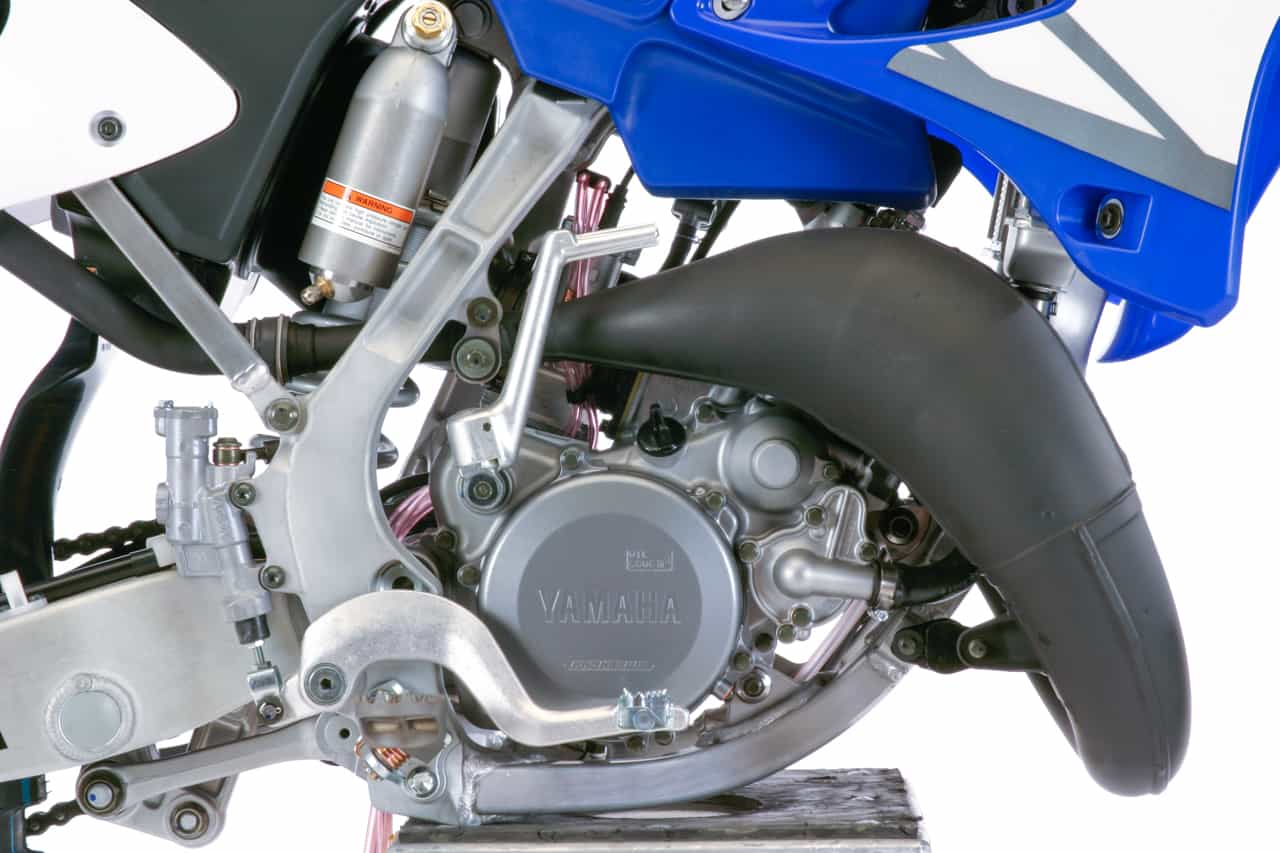 The 2005-2018 Yamaha YZ125 engine pumps out 34 horses where the new-age KTM 125SX pumps out 37 ponies.
The 2005-2018 Yamaha YZ125 engine pumps out 34 horses where the new-age KTM 125SX pumps out 37 ponies.
Q: DID WE TELL YOU IT HAD A SIX-SPEED TRANNY FROM A FIVE SPEED?
A: You bet we did. Yamaha’s engineers didn’t want to put the extra gear back in the tranny for 2005 (because it added weight to their super light bike), but the testing department convinced them it was a good idea. We loved the close-ratio gears of a six-speed 125…and we never liked the five-speed. Even with the much-improved six-speed transmission we still tested different rear sprockets on the 2005 YZ125, but unlike in years past, Yamaha shipped the 2005 YZ125 with good gearing.
Q: HOW CREATIVE WAS YAMAHA’S ALUMINUM FRAME AT THE TIME?
A: It’s was a work of art. Yamaha wasn’t gung-ho to jump on the aluminum bandwagon. They had a steel frame that was good. Their bikes had class-leading handling. They didn’t want to play follow the leader. According to inside sources, before Yamaha’s engineers could switch to aluminum they had to prove that there wouldn’t be any depreciation in strength, handling or feel. Weight savings was the big carrot. Yamaha eschewed the ubiquitous Delta Box twin-spar design and, instead, opted for a very innovative plug-and-play aluminum frame that mimicked a steel frame, but did it with only eight separate pieces. There isn’t a single tube on the 2005 frame. It uses forgings, castings and extrusions. The 2005 Yamaha YZ125 frame was 4-1/2 pounds lighter than the 2004 frame.
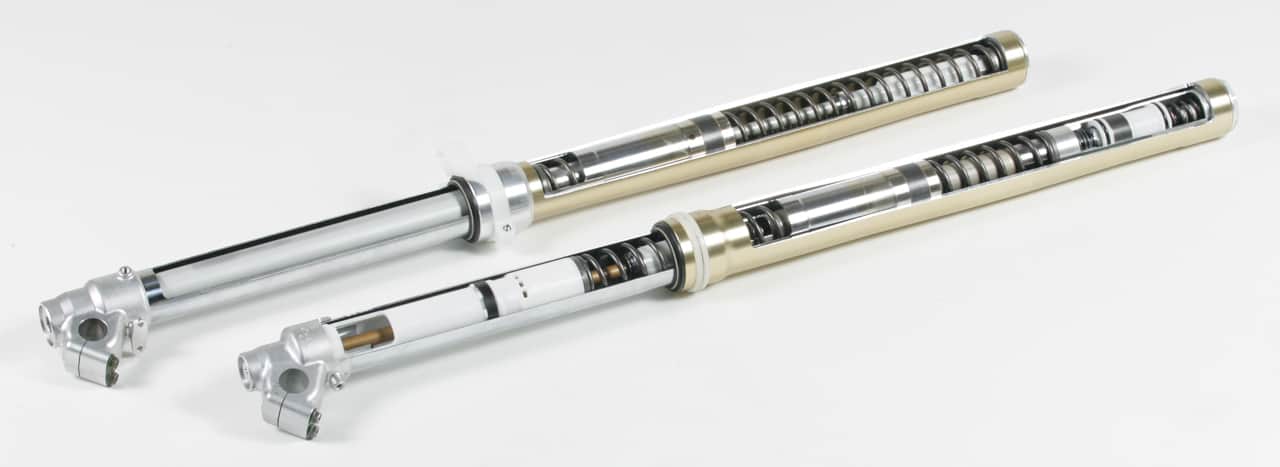 We loved the Kayaba SSS forks in 2005 and we still live then today.
We loved the Kayaba SSS forks in 2005 and we still live then today.
Q: WHAT ABOUT THE KAYABA SUSPENSION?
A: Yamaha would scold us every time we said the all-new Kayaba forks are copies of Showa’s Twin-Chamber forks. But, for the record, the Kayaba and Showa forks shared some remarkable similarities. For example, the Kayaba forks had a dual-chamber system just like Showa’s, the compression adjuster was located at the top of the forks just like Showa’s and the outer tube was a one-piece just like Showa’s. According to Kayaba sources at the time, KYB came up with the dual-chamber design first, but never really moved on it for production bikes, but instead ran it in their works suspension.
Q: DID THEY WORK BETTER THAN THE 2004 FORKS?
A: Absolutely. Yamaha’s 2005 forks were way better than anything they previously offered. They resisted bottoming like none of their old forks could, absorbed little bumps with ease and didn’t get harsh over the medium-sized stuff. The only adjustment we made to the forks was sliding them down in the triple clamps until they were flush and turning the compression to eight clicks out. We left the rebound alone.
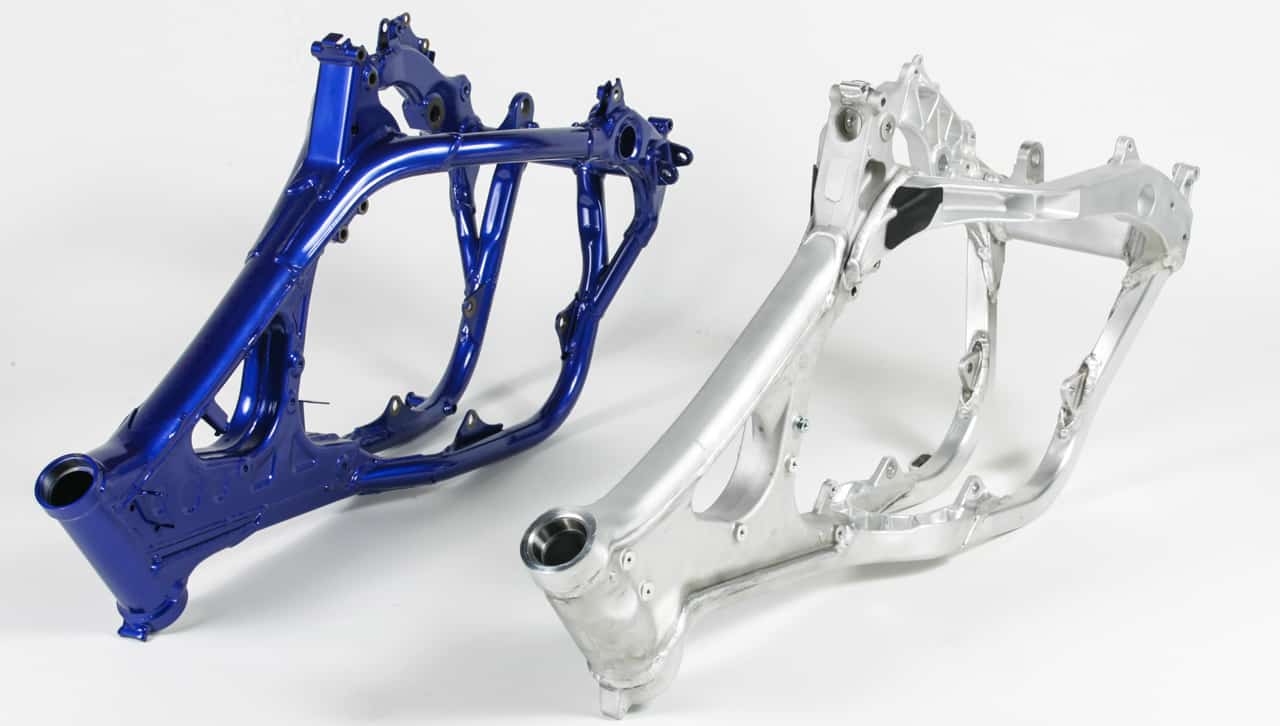 Left is the 2004 YZ125 steel frame. Right is the 2005-2018 aluminum YZ125 frame.
Left is the 2004 YZ125 steel frame. Right is the 2005-2018 aluminum YZ125 frame.
Q: WHAT DID WE HATE?
A: The hate list:
(1) Four-strokes. If they weren’t around this would’ve been be the best 125s ever built.
Q: WHAT DID WE LIKE?
A: The like list:
(1) Engine. It was smaller, lighter and faster than the 2004 engine. Yamaha took the 125cc two-stroke engine to a new level.
(2) Suspension. In 2004 Yamaha made a big jump by switching from 46mm to 48mm Kayabas. In 2005 they took a quantum leap forward from cartridge forks to dual-chamber forks.
(3) Weight. 197 pounds is light.
(4) Front brake. It was a good front brake for its time.
(5) Transmission. At the time more manufacturers should’ve followed Yamaha’s lead and ditched their five-speed trannies for six-speeds. It made a huge difference.
(6) Handlebars. Honda beat them to it, but in 2005 Yamaha came with aluminum Renthal handlebars as well.
(7) Handling. It turns on a dime, is stable down fast straights and jumps with ease.
Q: WHAT DO WE REALLY THINK?
A: This is an amazing 125. It is a super two-stroke that hasn’t changed over a decade later. Unfortunately, it is kind of like building a fast propeller-driven airplane. This is the jet age. It is also the four-stroke age.




Comments are closed.